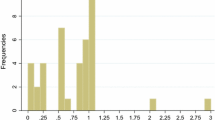Abstract
Procurement auctions carry substantial risk when the value of the project is highly uncertain and known only to insiders. This paper reports the results from a series of experiments comparing the performance of three auction formats in such complex and risky settings. In the experiment, every bidder knows the private value for the project but only a single insider bidder knows the common-value part. In addition to the standard second-price and English auctions we test the “qualifying auction,” a two-stage format commonly used in the sale of complex and risky assets. The qualifying auction has a fully “revealing” equilibrium that implements the revenue-maximizing outcome but it also has an uninformative “babbling” equilibrium in which bidders place arbitrarily high bids in the first stage. In the experiments, the latter equilibrium has more drawing power, which causes the qualifying auction to perform worse than the English auction and only slightly better than a sealed-bid second-price auction. Compared to the two other formats, the English auction is roughly 40% more efficient, yields 50% more revenues, avoids windfall profits for the insider, while protecting uninformed bidders from losses.
Similar content being viewed by others
References
Boone, J., & Goeree, J. K. (2009). Optimal privatization using qualifying auctions. Economic Journal, 119, 277–297.
Bulow, J., & Klemperer, P. (2002). Prices and the winner’s curse. RAND Journal of Economics, 33(1), 1–21.
Fischbacher, U. (2007). z-tree: Zurich toolbox for ready-made economic experiments. Experimental Economics, 10(2), 171–178.
Hernando-Veciana, A. (2004). Successful uninformed bidding. Games and Economic Behavior, 48, 29–53.
Hernando-Veciana, A., & Tröge, M. (2004). The insider’s curse, (Working paper). University of Alicante.
Kagel, J. H. (1995). Auctions: a survey of experimental research. In J. H. Kagel & A. E. Roth (Eds.), Handbook of experimental economics Princeton: Princeton University Press.
Kagel, J. H., & Levin, D. (2002). Common value auctions and the winner’s curse. Princeton: Princeton University Press.
Kagel, J. H., Pevnitskaya, S., & Ye, L. (2008, forthcoming). Indicative bidding: an experimental analysis. Games and Economic Behavior.
Murray, I. (2004). Tunnel vision that led to mindless English optimism. Marketing Week, May 13, pp. 82.
The Economist (2004). Business: under water; the channel tunnel. February 14.
Welch, Frémont (1998). The case-by-case approach to privatization: techniques and examples. World Bank.
Ye, L. (2007). Indicative bidding and a theory of two-stage auctions. Games and Economic Behavior, 58(1), 181–207.
Author information
Authors and Affiliations
Corresponding author
Electronic Supplementary Material
Rights and permissions
About this article
Cite this article
Boone, J., Chen, R., Goeree, J.K. et al. Risky procurement with an insider bidder. Exp Econ 12, 417–436 (2009). https://doi.org/10.1007/s10683-009-9221-0
Received:
Accepted:
Published:
Issue Date:
DOI: https://doi.org/10.1007/s10683-009-9221-0




